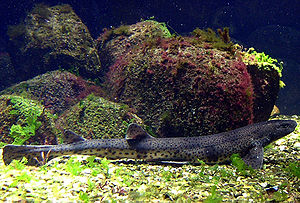Small spotted dogfish
| Small spotted dogfish | ||||||||||||
|---|---|---|---|---|---|---|---|---|---|---|---|---|

Small spotted dogfish |
||||||||||||
| Systematics | ||||||||||||
|
||||||||||||
| Scientific name | ||||||||||||
| Scyliorhinus canicula | ||||||||||||
| ( Linnaeus , 1758) |
The Kleingefleckte dogfish ( Scyliorhinus canicula ) is a small and egg-laying species of shark in the family of dogfish (Scyliorhinidae). It lives in the Mediterranean, the North Sea and on the west coast of North Africa as far as Senegal. It owes its name to its small spots and cat-like eyes.
features
Small-spotted cat sharks are slender, have a wedge-shaped figure and can be up to 100 centimeters long; however, their length is usually between 60 and 80 cm, while the weight is approximately 1000 to 1500 g. The age of the cat sharks is no more than eight years. Your skin is made up of small, hard scales that feel like sandpaper. The top is spotted brownish, while the bottom is light and almost spotless. In contrast to its closest relative, the large- spotted dogfish , it has very small spots and a longer nostril cleft that runs to its mouth. This is small and almost twice as wide as it is long. The black eyes are large and have the typical eye-line of cat sharks. It only has a small dorsal fin that sits very far back. The five gills are far below and are barely visible.
Spread and threat
Their distribution area extends from southwest Scandinavia over Great Britain and Spain to the coast of Senegal . They also live throughout the Mediterranean and the North Sea .
Small-spotted cat sharks are quite numerous in their range and are not endangered. Accordingly, the International Union for Conservation of Nature ( IUCN ) also lists the species in the Red List of Threatened Species as Least Concern .
There are different opinions about the taste of their meat; in some gourmet circles it is considered a delicacy , while the majority of gourmets do not attach any particular taste to it. The liver is considered poisonous.
Way of life
Although the nocturnal small-spotted cat sharks are usually solitary, one sees them again and again in schools of same-sex conspecifics. They live on the sea floor at a depth of up to 150 meters, but also like to live in coastal areas. Younger sharks in particular are more likely to be in shallower waters.
Reproduction
When mating, the two partners wrap around each other, the male inserts one of his two penises into the female's sexual opening and injects his sperm into it. A few weeks later the female lays the 18-20 eggs in shallow waters. These are located in horny, yellowish capsules 6 cm in length, the so-called sea mice (English "Mermaid's Purses"). The capsules are initially very transparent and become more and more milky. Their shape is elongated and rectangular; there are coiled threads at the four corners. If you roll them out, they are about 1 meter long. They are used to ensure that the capsule catches on underwater plants or seaweed. During the development period of 5 to 11 months, the embryo sometimes makes swimming movements to pump fresh water through the permeable walls. Usually only one embryo per sea mouse matures, but there is one known case in which two sharks were discovered in a capsule. After five months, they were successfully separated.
When hatching, the shark is about 10 cm long and still carries the remains of its yolk sac and from this point on has to fight independently for survival. With a length of 45 to 50 cm, the young shark finally becomes sexually mature.
food
The small-spotted dogfish hunts slow crustaceans and mollusks that live on the ocean floor. It mainly eats shrimp , crayfish , squid , octopus , worms , small fish and snails . With the help of thousands of electrical sensors on its snout and a well-developed sense of smell, it can track down its prey even in poor visibility. With the sensors he can feel the electromagnetic field of animals. He uses his small, bristle-like teeth to bite into snail shells.
literature
- Alessandro de Maddalena, Harald Bänsch: Sharks in the Mediterranean. Franckh-Kosmos, Stuttgart 2005, ISBN 3-440-10458-3 , pp. 158-160.
- Leonard Compagno , Marc Dando, Sarah Fowler: Sharks of the World (= Princeton Field Guides ). Princeton University Press , Princeton et al. 2005, ISBN 0-691-12072-2 , p. 247.
- Leonard JV Compagno: Sharks of the world. An annotated and illustrated catalog of shark species known to date. Part 2: Carcharhiniformes (= FAO Fisheries Synopsis. No. 125, Volume 4, Part 2). United Nations Development Program et al., Rome 1984, ISBN 92-5-101383-7 , pp. 366-367, ( complete PDF , species portrait ).
Individual evidence
- ↑ Scyliorhinus canicula in the endangered Red List species the IUCN 2009. Posted by: Ellis, J., Mancusi, C., Serena, F. Haka, F., Guallart, J. Ungaro, N., Coelho, R. , Schembri, T. & MacKenzie, K., 2008. Retrieved March 4, 2010.
- ↑ Archived copy ( memento of the original from September 8, 2005 in the Internet Archive ) Info: The archive link was inserted automatically and has not yet been checked. Please check the original and archive link according to the instructions and then remove this notice.
Web links
- Entry on Hai.ch (German)
- Small spotted dogfish on Fishbase.org (English)


